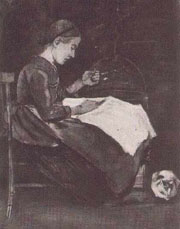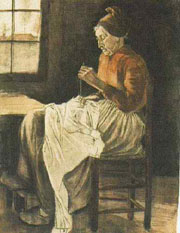



If Youth But Knew ------ What Age Can Tell
BEFORE YOU BEGIN --- THINK CAREFULLY
Making a Hawaiian Quilt is a major project which for even an experienced quilter takes from 6 months to a year to complete. For a novice it may well take considerably longer. If you have never quilted or are not sure of your needlework abilities start with a smaller project, a cushion or a wall-hanging.
Many bookstores carry inexpensive books of Hawaiian pillow patterns. On-line, both Amazon.Com and Barnes & Noble have an excellent assortment. PBS has a sampler collection of pillow patterns available through its Hawaiian Quilting television series. These books contain simplified instructions or the following instructions may be modified for smaller items.
If you decide to continue, by all means join a quilt club. The help, encouragement and support you receive from other quilters will be a most valuable asset. At times when you feel discouraged it may be essential to successful completion of your quilt.
Plan to do a little work on your quilt every day if at all possible. You will be pleasantly surprised at
the progess you make.
SELECT YOUR PATTERN
Hawaiian quilt designs may be either traditional or modern regardless of subject matter. The choice is entirely a matter of personal preference. If this is your first quilt it is probably best to choose a relatively simple pattern. Look at as many pictures of quilts as possible before making a decision. Check those
available on the Honu Hale LINKS page as well as in books.
You must also decide whether you want your quilt to be a coverlet or a floor-length bedspread. Size is usually indicated on the quilt pattern but it is wise to check by laying the pattern on your bed, placing the designated center of the pattern in the center of the bed. In most Hawaiian quilts the central motif covers the top of the bed, but there are exceptions, eg. all-over patterns. Adjustments can be made at the edges of almost all quilts by decreasing or extending the border width.
FABRIC and PREPARATION
The traditional and still preferred fabric for quilts is 100% cotton broadcloth. Firm textured cotton-polyester blends may be used successfully but are somewhat harder to quilt. Solid colors, usually bright or dark on lighter shades are traditional but prints may be and often are used, particularly as quilt backings. Always wash and iron fabric before using to avoid later shrinkage. Colored fabrics should be soaked in a strong salt-water and vinegar solution before washing to set colors.
You will need three large squares of fabric, slightly larger than the desired size of the finished quilt ---one each for the design, the background and the backing. To achieve this it is necessary to sew strips of fabric together. When doing so keep a full width of fabric in the center with narrower pieces on the sides. Trim selvages before sewing.
Press seams on pattern fabric toward the center and on background toward the outside edges. This reduces the number of fabric layers through which you must eventually quilt in the seam areas. Save all extra fabric for later use as binding strips. A floor-length Queen size quilt is approximately 100-104 inches square. Each large square requires about 9 yards of fabric, a total of 27 yards.
FOLD and CUT
Most Hawaiian quilts are cut "snowflake" fashion with the fabric folded into 1/8ths. This produces a symetrical design in which each quadrant of the finished quilt is the same.
Start by folding the pattern fabric lengthwise (with the grain) into 1/2s, then crosswise into 1/4ths. Finally, fold on the diagonal into 1/8ths with the center of the fabric at one point of the resulting triangle. Press folds at each step of this process. Follow the same procedure with the background fabric. The backing is not needed at this time and may be set aside.
Check your pattern. You will notice that it is almost certainly for 1/8 of a quilt. Lay pattern on the fabric to be used for the design with the designated center of the pattern at the point of the folded triangle which is the center of the fabric. This will be the "PIKO" or center of your quilt and is very important. The pattern will indicate proper placement of edges on straight and bias folds of triangle.
Pin pattern securely to fabric through all layers. Cut out carefully, using more pins if necessary to be sure pattern does not slip. For smooth cutting use very sharp scissors as you are cutting through 8 layers of fabric. Many quilters prefer Ginghers.
Quilt designs often have openings indicated as slits or small cut-out areas in the pattern. These are called "PUKAS". They may represent either a specific design element eg. the center of a flower, the eye of an animal; or be intended to give a feeling of openness to the overall design.
If indicated as slits they are best cut with a straight edged razor blade in a holder. For very small cut-outs, make a nick in the center with the tip of your scisssors rather than cutting out completely. More about this later in the Applique section.
LAY OUT, PIN and BASTE
For this you need a large flat surface. Several folding tables placed side-by-side work best. If tables are not available, the floor may be used.
Spread background material flat and fasten to surface
with tape or pins. Starting at the center, unfold design fabric very carefully on background matching lengthwise and crosswise folds, seams in fabric layers, and design elements. Ease design into place so pattern lies smoothly on background. Pin design and background layers together securely as you move out from center.
Measure distances when necessary to be sure placement is correct and adjust accordingly. Where design elements are supposed to match on straight and diagonal folds, make sure they do. This step is rather time-consuming but essential to successful completion of your quilt.
Once you think placement is correct, check again. Some final adjustments are usually necessary. Your quilt top is now ready for basting.
Loosen edges of background fabric from the work surface in order to baste. If you have been working on the floor, move quilt top to a table.
Again starting at the center baste around the entire design, including around the edges of Pukas, with stitches 3/4-1 inch long and approximately 1/2 inch in from edges. Any commmercial sewing thread, preferably white, can be used. A long thin needle such as a Milliners needle is best for basting. When all basting has been completed you are ready to move on to the next step.